The Apple Project: Mapping Stories, Tasting History
Exploring heritage apples through stories, tastings, and a little bit of science
Welcome to the Michelle Seguin MD newsletter! I’m Dr. Michelle, and I’m so glad you’re here. This week I am sharing the beginning of an apple project on our farm, a journey of mapping, tasting, and tending the old trees scattered across the land.
Hello friends,
The apples are what called me to say it out loud at last: this is our farm. For a long time I hesitated to use that word, since we are still building our home here and not yet living on the land. But it has been farmed before, once planted in potatoes (and apples as we’ll soon discuss), and now it is slowly being renewed with our garden, apiary, new orchards, and soon a house of our own. These early September days have been filled with apples…gathering, tasting, and wondering at their stories. This week we began a new project that blends mapping, curiosity, and memory, a practice of observation. Join me!
With gratitude,
Dr. Michelle
From the Seasonal Logbook
September 10th - Temperature: 58°F, cloudy skies, no wind and patchy fog along the hillside.
Walking the land last night, I found myself counting apple trees the way others count stars. More than one hundred scattered across these hillsides, each one holding stories we are only beginning to uncover. Some are clearly feral, volunteers that found their own way to sunlight and soil. Others, with particular shapes of leaf and fruit, seem to carry deeper history, planted by hands long gone.
This is how our Apple Project began, not with expertise but with genuine curiosity.
Our Apple Project
I’m approaching this heritage apple investigation with the wide-eyed wonder of a beginner, and honestly, that feels like exactly where I need to be. Each day offers the invitation to look at the land with fresh eyes, to notice what we have been walking past without really seeing. It is never too late to become a student of the soil that holds you.
As of late, our picnic table has transformed into mission control: a corkboard displaying our first seven mystery trees, each photographed and numbered, connected by colored pins to their places on our aerial property map. It looks like an archaeological site, each specimen carefully marked, slowly revealing patterns of cultivation that hint at how people once lived and planted here.
The research is unfolding in layers: photographs cataloguing leaf and fruit, spreadsheets taking shape, calls to the historical society whose archives might hold clues. I have reached out to neighboring farmers, purchased a dog-eared copy of Apples of North America, and we plan to send leaf samples from our most promising varieties to Washington State University for genetic evaluation. It will be four months before we know what the DNA reveals, but in the meantime, the waiting is part of the wonder.
Gifts From People Long Gone
Some of these trees might be heritage varieties brought by Cornish and Finnish immigrants during the copper boom of the 1860s-1890s. Flavors deemed worth carrying across an ocean, genetics selected for surviving Upper Michigan winters while feeding families through seasons of backbreaking mine work. We already suspect a few names might surface here: the Duchess of Oldenburg, a hardy Russian variety beloved in Finnish communities, or the Alexander, another 19th-century immigrant apple known for its striking red skin and ability to withstand northern climates.
This all has me thinking about John Bunker, the founder of Fedco Trees, who has dedicated his life to preserving heritage apple varieties. In a beautiful PBS Kitchen Vignette, he reflects on the ancient apple trees he encounters (and his method for the perfect apple pie):
"These trees that I'm getting to know - these ancient trees were gifts to us from people long gone. It was to me arrogant to see this gift and to let it die…
What I love most about apple growing is the partnership between me and the tree. Agriculture in its broadest sense is a partnership between a person and plant." —John Bunker
This is the medicine I did not know I was looking for: the reminder that tending these mystery trees is not just botanical curiosity but an act of honoring. Honoring the hands that planted them, the dreams they carried, the partnership they still offer us today.
And perhaps they knew something we are rediscovering: that “an apple a day keeps the doctor away” is not only folk wisdom but nutritional truth. Each variety carries its own profile of fiber, antioxidants, and phytonutrients.
Did you know?
Every apple carries its own tiny ecosystem. Peel, pulp, seeds, and stem end each hold different communities of microbes, and a single apple can bring millions of them into your body. One study found that organically grown apples tended to hold an even greater diversity of these microbes compared to conventional, which makes me wonder what hidden diversity might live within our older heritage trees.
Creating Your Own Apple Evening (Omenailta)
Here in Michigan, the fall ritual of cider and donuts at a local orchard is its own kind of seasonal institution. When I lived downstate during medical school, everyone made the trip at least once each autumn. But there is another way to celebrate: bring home a basket of unique apple varieties, or gather a few from a neighbor’s tree (with permission), and host a simple tasting at home.
Last night we held our first apple tasting dinner, what the Finns would have called omenailta, or “apple evening.” It felt fitting to honor the heritage of these trees with a simple ceremony that gave each apple the attention it deserved. Some tasted of honey and flowers, others carried a distinctly grassy scent. Most leaned sweet, which surprised us, as we thought surely one would deliver that sharp, mouth-puckering tartness, but not this round.
Here's how to create your own apple tasting experience:
Setup:
Gather 5-6 apple varieties, sliced fresh with peels on
Arrange neutral palate cleansers: plain crackers, crusty bread, water
Create simple tasting sheets (or use the one I created below)
Optional: small glasses for any pressed juice, cider
The Tasting Process:
Look: Notice skin color, shape, size, and variation
Touch: Feel for firmness and skin texture
Smell: Breathe in the aromatics at the stem end
First bite: Listen for the crunch, note first impressions
Chew mindfully: Notice how the flavors change and develop
Finish: What lingers? What calls you back for another bite?
Pairing Suggestions (From The Flavor Bible):
Cheeses: Sharp aged cheddar, goat cheese, camembert
Local honey or fruit preserves (apricot, currant)
Roasted nuts such as walnuts or pecans
Fresh herbs such as thyme or rosemary
Pork or poultry if you’d like to extend into a meal
Note-Taking Categories:
Texture: Crisp, mealy, dense, juicy
Sweetness and tartness
Flavor notes: Floral, spicy, wine-like, honey, citrus
Finish: Short, lingering, astringent
The goal is not expertise but presence. Taste slowly, share impressions, and let the apples tell their own stories. Remember, these are gifts!
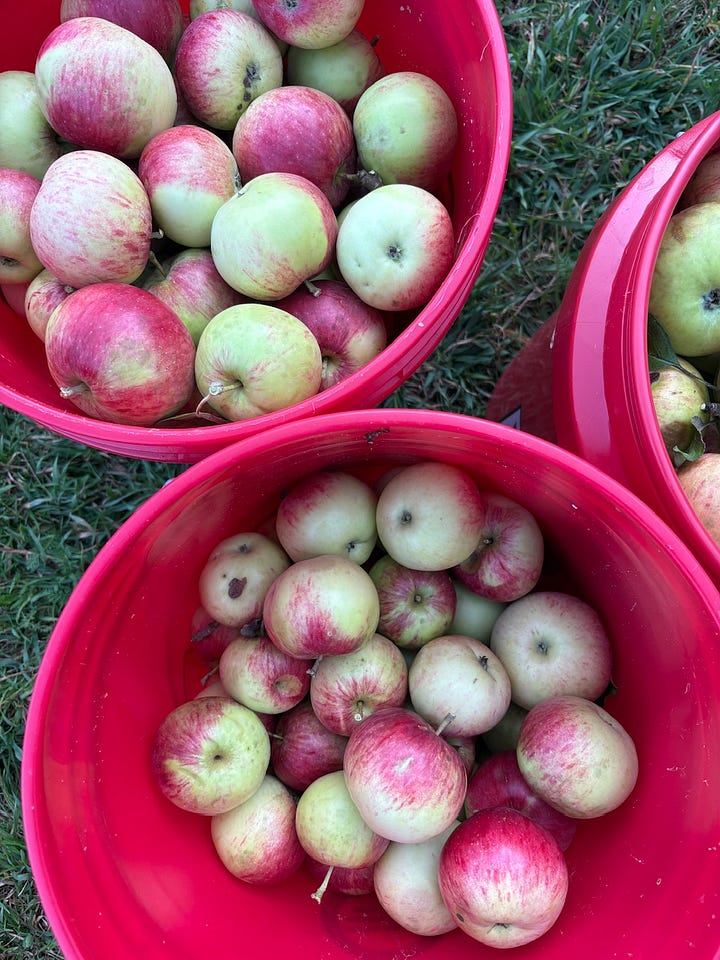
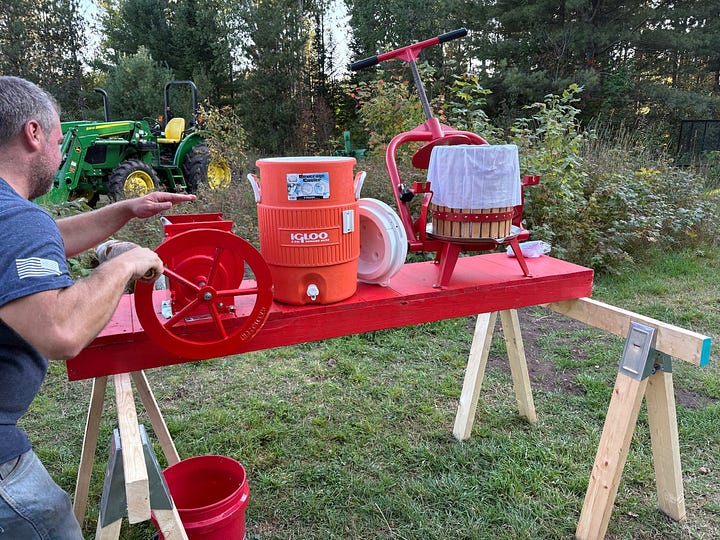

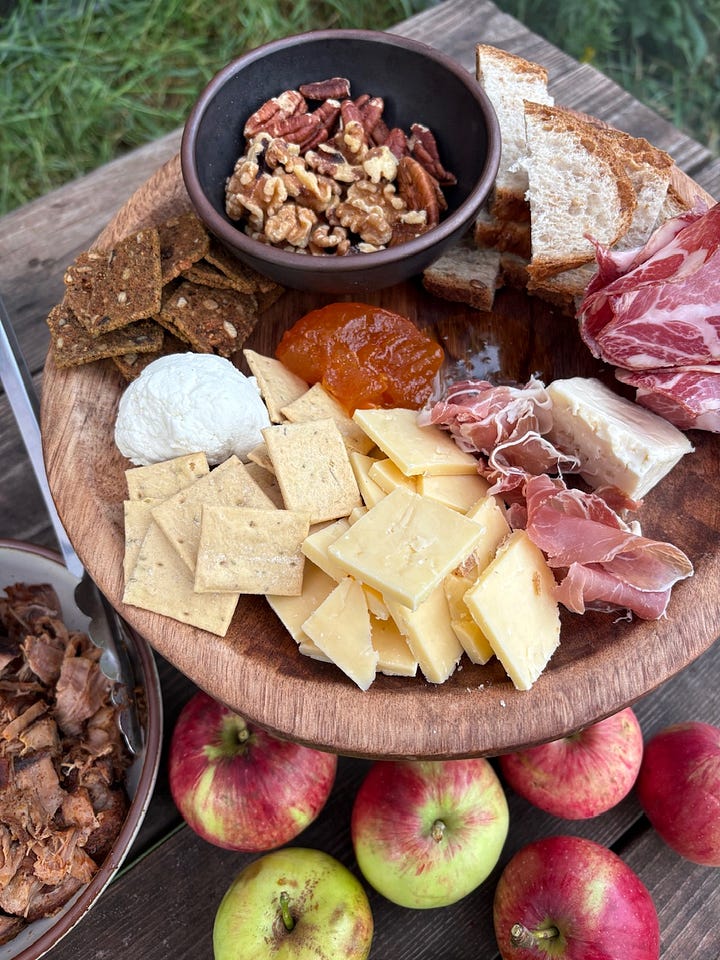
1. Apples ready for pressing and tasting. 2. Cider pressing in progress 3. First pour of the season 4. Omenailta spread: cheeses, honey, bread, and the flavors that bring each bite to life
Want to try your own Omenailta? Download and print the Apple Tasting Field Notes sheet below, gather a few apples, and make an evening of it. If you do, I’d love to hear about your discoveries. Share them in the comments or send me a note!
Psst…in case you were wondering…#1 was our favorite all-round apple in this tasting!
Seasonal Apple Inspiration
After our tasting, I kept thinking about all the ways apples invite us to the table. They can be simple and raw, or transformed with heat and spice into something deeply comforting. Here are some recipes and inspirations from writers and cooks who understand the quiet medicine of cooking with intention:
-
Our featured author this month (and the creative mind behind Ruffage). Did you know she also wrote Pulp, a love letter to fruit? Her apple chapter alone offers raw, roasted, poached, stewed, and baked preparations. These little poached apples make the perfect fruit course (something I recommend trying if you haven’t already). Plus, these East Fork Ice Cream dishes are perfect for serving fruit. Honey and Oats Cake with Apple Butter —
A nourishing cake from a fellow food-loving physician, layered with the warmth of cooked oats and the comfort of apple butter.Roasted Apple-Almond Cake with Cardamom —
A timeless recipe from her second book (which I’ll be featuring later this fall in the cookbook club—yay). The blend of apples, almonds, and cardamom come together in a cake that tastes like autumn in every bite. It’s one that I make every fall.Shaved Fennel & Apple Salad with Creamy Lemon-Miso Dressing —
Featured by The New Family Table ( ), this salad is crisp, bright, and layered with flavor. Thinly shaved fennel, apple, and celery are tossed with pecans, aged Gouda, and a lemon-miso dressing that wakes everything up. A reminder that apples belong at the savory table too.-
A make-ahead breakfast layered with oats, apples, and warm spices. Comforting like apple pie, yet balanced enough to carry you through the morning. Curried Lentil, Potato, Cauliflower Soup —
Hearty and warming, this soup earns a place in the fall rotation. Apples bring an unexpected brightness to the earthy lentils and vegetables.Pork with Apples and Black Grapes —
Because sometimes the season calls for a dish that is rustic, soulful, and a little indulgent.Bonus Inspiration: Chasing 100 Apples This Season by
— a Substack project dedicated to tasting 100 varieties in one year. A joyful reminder of the infinite diversity hidden inside a simple apple.
In Closing
What strikes me most about this apple project is how it reminds me that curiosity is always available to us. We don’t need permission or expertise to begin noticing the gifts that surround us. Whether it is one hundred apple trees on a hillside or a single potted herb on a windowsill, the invitation is the same: look closer, learn deeper, tend more carefully.
In our disconnected world, this kind of attention to season, to heritage, to the plants that feed us feels like radical medicine. It asks us to slow down, to remember that we are part of something larger than ourselves.
Every day offers the chance to become a student again. Every tree, every taste, every moment of genuine curiosity brings us home to ourselves and to the places that hold us.
The apple trees have been patient teachers, waiting decades for someone to notice their stories. I am grateful to finally be learning to listen.
What's growing in curiosity around you? I'd love to hear about your own heritage investigations, apple tastings, or moments of beginner's mind in the comments below.
With love and care,
Dr. Michelle
P.S. I will share updates as we continue this project, with more installments to come. There is no need to rush the process. If you enjoyed this letter, I would be so grateful if you gave it a like, re-stack, or passed it along to a friend. Each share helps this community grow. Thank you for being part of this journey with me.
Here are my most recent Substack sharings:



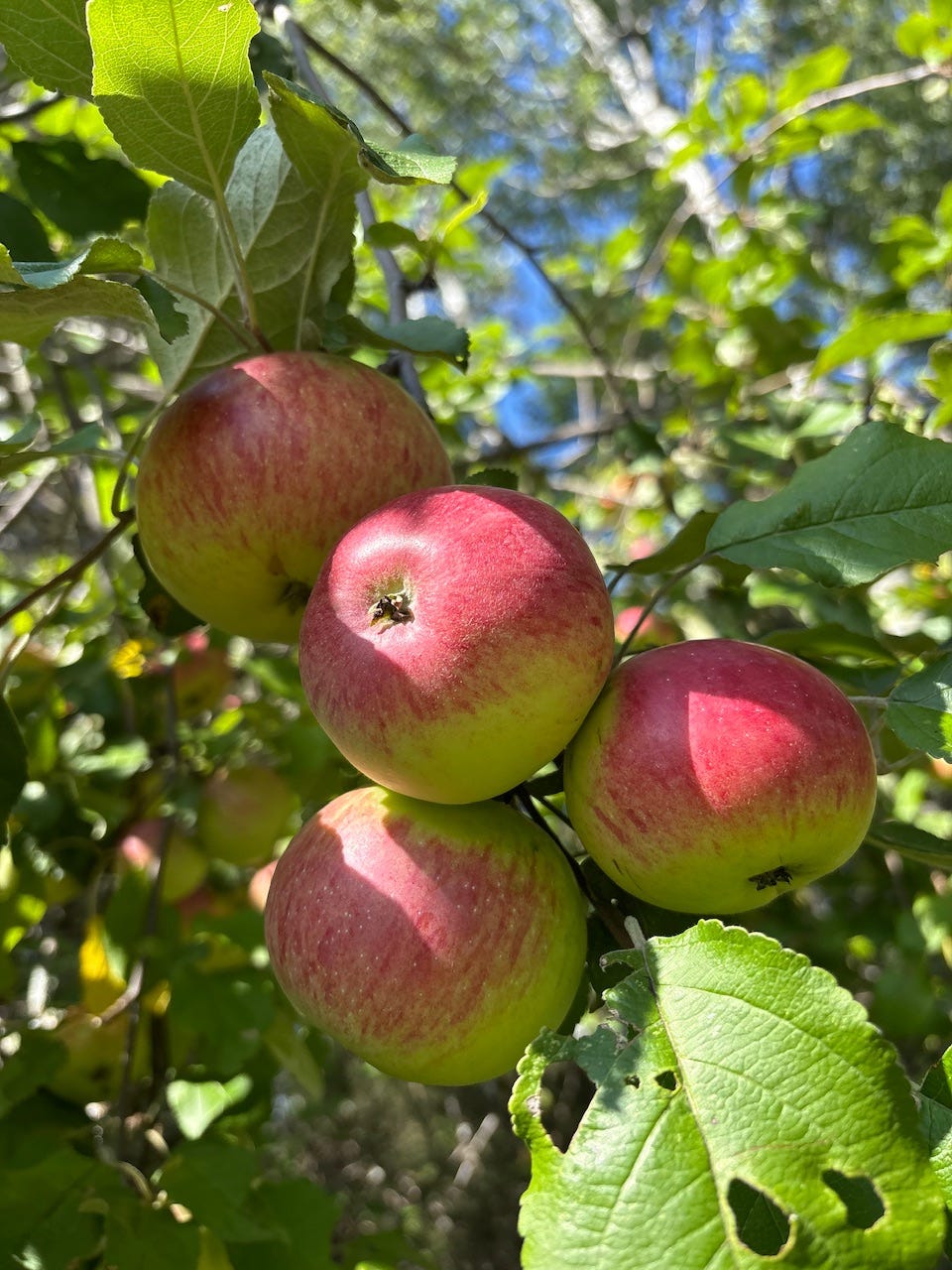
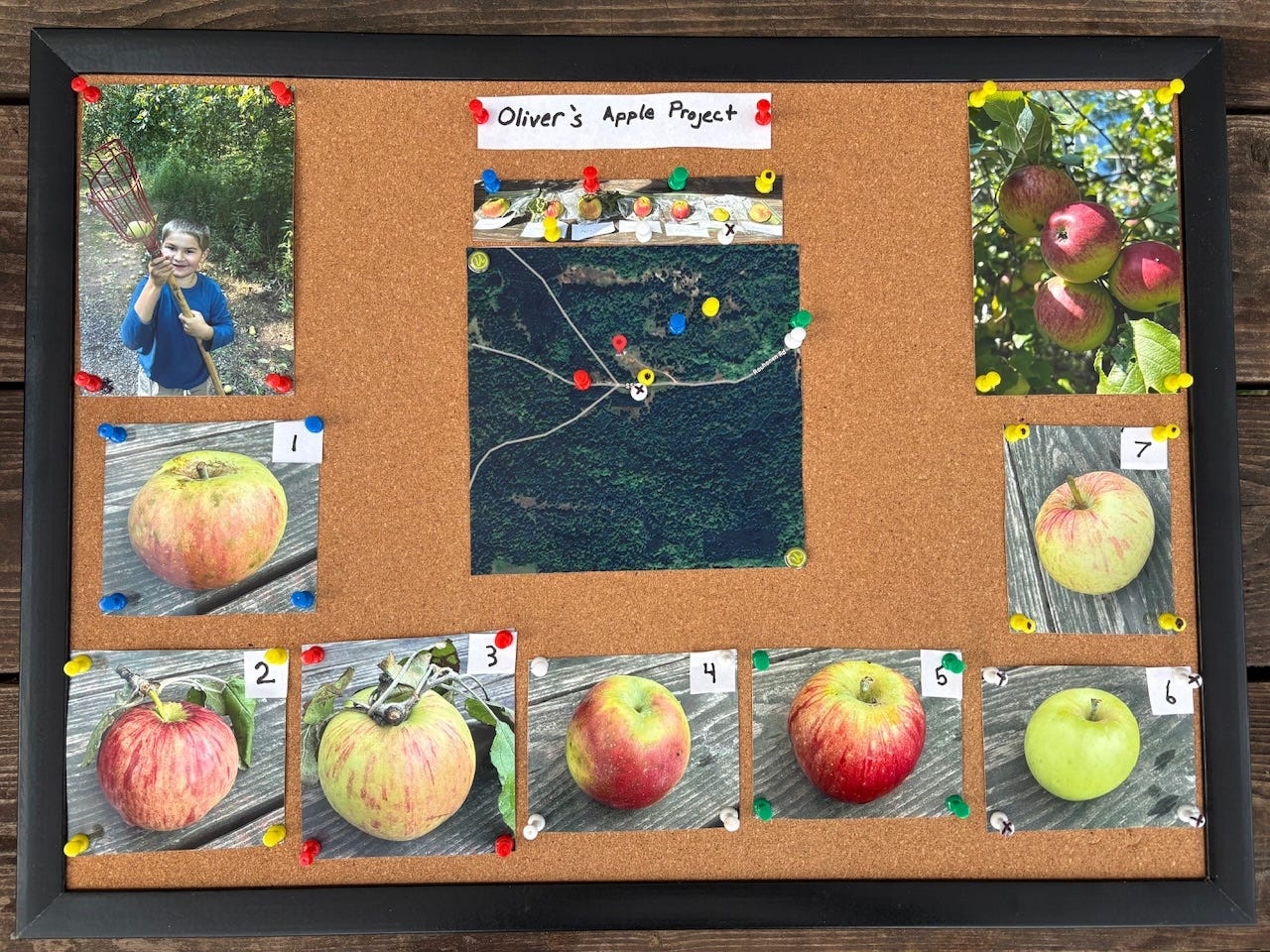
Thanks for the shout out!
I love everything about this from the apple tasting to trying to discover what these apples are. I can't wait to hear the results.